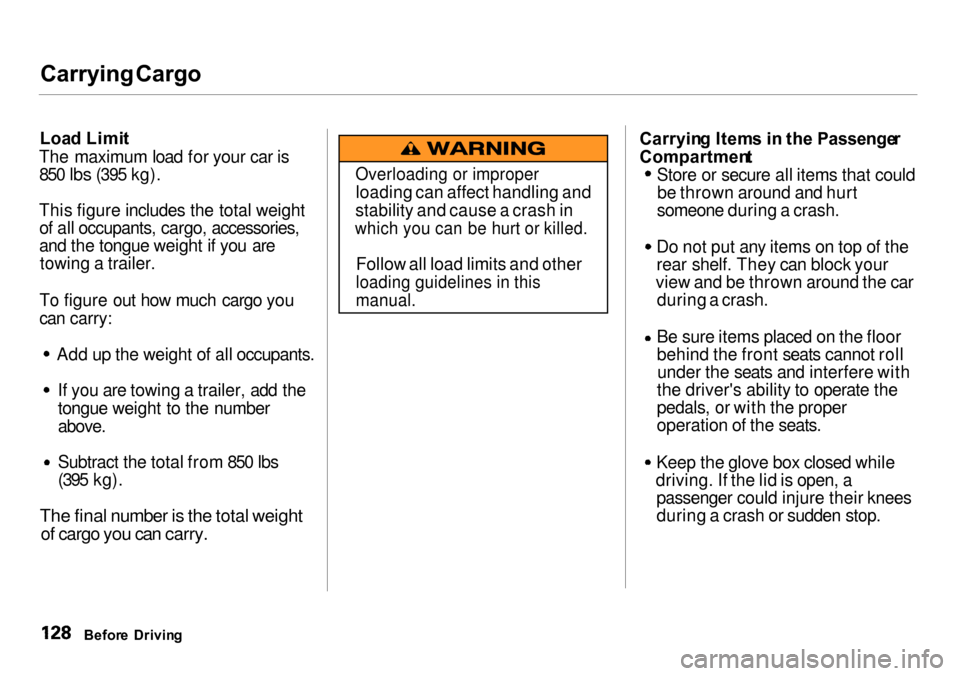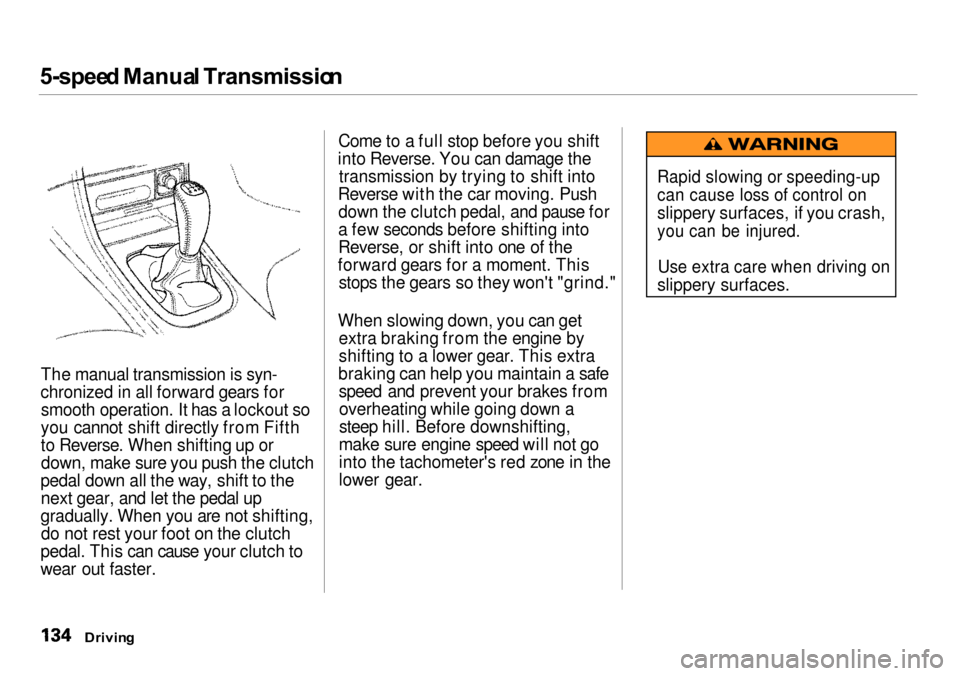Acura Integra 2000 Sedan Owner's Manual
Manufacturer: ACURA, Model Year: 2000, Model line: Integra, Model: Acura Integra 2000Pages: 273, PDF Size: 4.4 MB
Page 131 of 273

Carrying
Cargo
Loa d Limi t
The maximum load for your car is 850
lbs
(395 kg).
This figure includes the total weight of all occupants, cargo, accessories,
and the tongue weight if you are towing a trailer.
To figure out how much cargo you
can carry:
Add up the weight of all occupants. If you are towing a trailer, add the
tongue weight to the number
above.
Subtract the total from 850 lbs
(395 kg).
The final number is the total weight
of cargo you can carry.
Carryin
g Item s i n th e Passenge r
Compartmen t Store or secure all items that could
be thrown around and hurt
someone during a crash. Do not put any items on top of the
rear shelf. They can block your
view and be thrown around the car during a crash.
Be sure items placed on the floor
behind the front seats cannot rollunder the seats and interfere with
the driver's ability to operate the
pedals, or with the proper
operation of the seats. Keep the glove box closed while
driving. If the lid is open, a passenger could injure their knees
during a crash or sudden stop.
Befor e Drivin g
Overloading or improper
loading can affect handling and
stability and cause a crash in
which you can be hurt or killed.
Follow all load limits and other
loading guidelines in this
manual.
Page 132 of 273

Carrying
Cargo
Carryin g Carg o i n th e Trun k o r o n
a Roo f Rac k Distribute cargo evenly on the
floor of the trunk, placing the
heaviest items on the bottom and
as far forward as possible.
If you fold down the back seat, tie
down items that could be thrown
about the car during a crash or
sudden stop. If you carry large items that
prevent you from closing the
hatch, exhaust gas can enter the
passenger area. To avoid the
possibility of carbon monoxide
poisoning, follow the instructions
on page 49 .
If you can carry any items on a
roof top carrier, be sure the total weight of the rack and the items
does not exceed the maximum
allowable weight. Please contact your Acura dealer for further
information.
Before Drivin g
Page 133 of 273

130
Page 134 of 273

Drivin
g
This section gives you tips on starting the engine under various
conditions, and how to operate the
5-speed manual and automatic
transmissions. It also includes
important information on parking
your car, the braking system, and facts you need if you are planning to
tow a trailer.
Preparing to Drive......................... 132
Starting the Engine........................ 133
Starting in Cold Weather at High Altitude ..................... 133
5-speed Manual Transmission..... 134 Recommended Shift Points...... 135
Engine Speed Limiter............... 135
Automatic Transmission............... 136
Shift Lever Position Indicator.. 136
Shift Lever Positions................. 136
Engine Speed Limiter............... 138
Shift Lock Release..................... 139
Parking............................................ 140
The Braking System...................... 141 Brake Wear Indicators.............. 141
Brake System Design................ 142
Anti-lock Brakes........................ 142 Important SafetyReminders.......................... 143
ABS Indicator......................... 144
Driving in Bad Weather................ 145
Towing a Trailer............................ 147
Driving
Page 135 of 273

Preparin
g to Driv e
You should do the following checks and adjustments every day before
you drive your car.
1. Make sure all windows, mirrors, and outside lights are clean and
unobstructed. Remove frost, snow,
or ice.
2. Check that the hood and trunk are fully closed.
3. Visually check the tires. If a tire looks low, use a gauge to check its
pressure.
4. Check that any items you may be carrying with you inside are stored
properly or fastened down
securely.
5. Check the adjustment of the seat
(see page 75 ).
6. Check the adjustment of the inside and outside mirrors (see
page 81 ).
7. Check the adjustment of the steering wheel (see page 65 ).
8. Make sure the doors are securely
closed and locked.
9. Fasten your seat belt. Check that
your passengers have fastened
their seat belts (see page 15 ). 10.Turn the ignition switch ON (II).
Check the indicator lights in the
instrument panel.
11.Start the engine (see page 133 ).
12.Check the gauges and indicator lights in the instrument panel (see
page 53 ).
Drivin g
Page 136 of 273

Startin
g th e Engin e
1. Apply the parking brake.
2. In cold weather, turn off all electrical accessories to reduce
the drain on the battery.
3. Manual Transmission:
Push the clutch pedal down all the
way. START (III) does not
function unless the clutch pedal is
depressed.
Automatic Transmission:
Make sure the shift lever is in
Park. Press on the brake pedal.
4. Without touching the accelerator pedal, turn the ignition key to the
START (III) position. If the enginedoes not start right away, do not
hold the key in START (III) for
more than 15 seconds at a time.
Pause for at least 10 seconds
before trying again. 5. If the engine does not start within
15 seconds, or starts but stalls
right away, repeat step 4 with the
accelerator pedal pressed half-way
down. If the engine starts, release
pressure on the accelerator pedal
so the engine does not race.
6. If the engine still does not start, press the accelerator pedal all the
way down and hold it there while
starting in order to clear flooding.
As before, keep the ignition key in
the START (III) position for no
more than 15 seconds. Return to
step 5 if the engine does not start.
If it starts, lift your foot off the
accelerator pedal so the engine
does not race.
Startin g in Col d Weathe r a t Hig h
Altitud e (Abov e 8,00 0 feet /
2,40 0 meters )
An engine is harder to start in cold weather. The thinner air found at
high altitude above 8,000 feet (2,400 meters) adds to the problem.
Use the following procedure:
1. Turn off all electrical accessories to reduce the drain on the battery.
2. Push the accelerator pedal half- way to the floor and hold it there
while starting the engine. Do not
hold the ignition key in START
(III) for more than 15 seconds.
When the engine starts, release
the accelerator pedal gradually as
the engine speeds up and smooths
out.
3. If the engine fails to start in step 2, push the accelerator pedal to the
floor and hold it there while you
try to start the engine for no more
than 15 seconds. If the engine
does not start, return to step 2.
Driving
Page 137 of 273

5-spee
d Manua l Transmissio n
The manual transmission is syn-
chronized in all forward gears for smooth operation. It has a lockout so
you cannot shift directly from Fifth
to Reverse. When shifting up or down, make sure you push the clutch
pedal down all the way, shift to the next gear, and let the pedal up
gradually. When you are not shifting, do not rest your foot on the clutch
pedal. This can cause your clutch to
wear out faster. Come to a full stop before you shift
into Reverse. You can damage the transmission by trying to shift into
Reverse with the car moving. Push down the clutch pedal, and pause for
a few seconds before shifting into
Reverse, or shift into one of the
forward gears for a moment. This stops the gears so they won't "grind."
When slowing down, you can get extra braking from the engine by
shifting to a lower gear. This extra
braking can help you maintain a safe speed and prevent your brakes fromoverheating while going down a
steep hill. Before downshifting,
make sure engine speed will not go
into the tachometer's red zone in the
lower gear.
Drivin g
Rapid slowing or speeding-up
can cause loss of control on
slippery surfaces, if you crash,
you can be injured.
Use extra care when driving on
slippery surfaces.
Page 138 of 273

5-spee
d Manua l Transmissio n
Recommende d Shif t Point s
Drive in the highest gear that lets
the engine run and accelerate smoothly. This will give you the best
fuel economy and effective emis- sions control. The following shiftpoints are recommended: Engin
e Spee d Limite r
If you exceed the maximum speed for the gear you are in, the engine
speed will enter into the tachometer's
red zone. If this occurs, you may feel the engine cut in and out. This is
caused by a limiter in the engine's
computer controls. The engine will run normally when you reduce the
RPM below the red zone.
Before downshifting, make sure the
engine will not go into the tachometer's red zone in the lower
gear.
Driving
Page 139 of 273

Automati
c Transmissio n
Your Acura's transmission has four
forward speeds, and is electronically controlled for smoother shifting. It
also has a "lock-up" torque converter
for better fuel economy. You may
feel what seems like another shift when the converter locks. Shif
t Leve r Positio n Indicato r
This indicator on the instrument
panel shows which position the shift
lever is in.
The "D4" indicator comes on for a
few seconds when you turn the
ignition switch ON (II). If it flashes
while driving (in any shift position),
it indicates a possible problem in the
transmission. Avoid rapid acceler-
ation and have the transmission
checked by an authorized Acura
dealer as soon as possible. Shif
t Leve r Position s
The shift lever has seven positions.
It must be in Park or Neutral to start the engine. When you are stopped in
D4, D3, 2,1, N or R, press firmly on
the brake pedal, and keep your foot
off the accelerator pedal.
Drivin g
SHIF
T
LEVE R
Page 140 of 273

Automati
c Transmissio n
Par k (P ) — This position mechani-
cally locks the transmission. Use
Park whenever you are turning off or starting the engine. To shift out of
Park, you must press on the brake
pedal and have your foot off the accelerator pedal. Press the release
button on the side of the shift lever
to move it. If you have done all of the above and
still cannot move the lever out of
Park, see Shift Lock Release on page
139.
You must also press the release button to shift into Park. To avoid
transmission damage, come to a
complete stop before shifting into
Park. The shift lever must be in Park
before you can remove the key from
the ignition switch. Revers
e (R ) — To shift to Reverse
from Park, see the explanation under Park. To shift to Reverse from
Neutral, come to a complete stop and
then shift. Press the release button before shifting into Reverse from
Neutral.
Neutra l (N ) — Use Neutral if you
need to restart a stalled engine, or if
it is necessary to stop briefly with
the engine idling. Shift to Park posi-
tion if you need to leave the car for any reason. Press on the brake pedal
when you are moving the shift lever
from Neutral to another gear.
Driv e (D 4) — Use this position for
your normal driving. The transmis- sion automatically selects a suitable
gear for your speed and acceleration.
You may notice the transmission shifting up at higher speeds when
the engine is cold. This helps the
engine warm up faster.
Driving
CONTINUED